Key takeaways:
- The process of stuffing sausages is steeped in tradition and creativity, transforming it into a meaningful culinary experience.
- Essential tools for sausage making include a stuffer, grinder, natural casings, and temperature probe, all of which enhance the experience and quality of the sausages.
- Key techniques for successful sausage stuffing involve chilling the mixture, ensuring proper filling techniques, and allowing stuffed sausages to rest before cooking for optimal flavor.
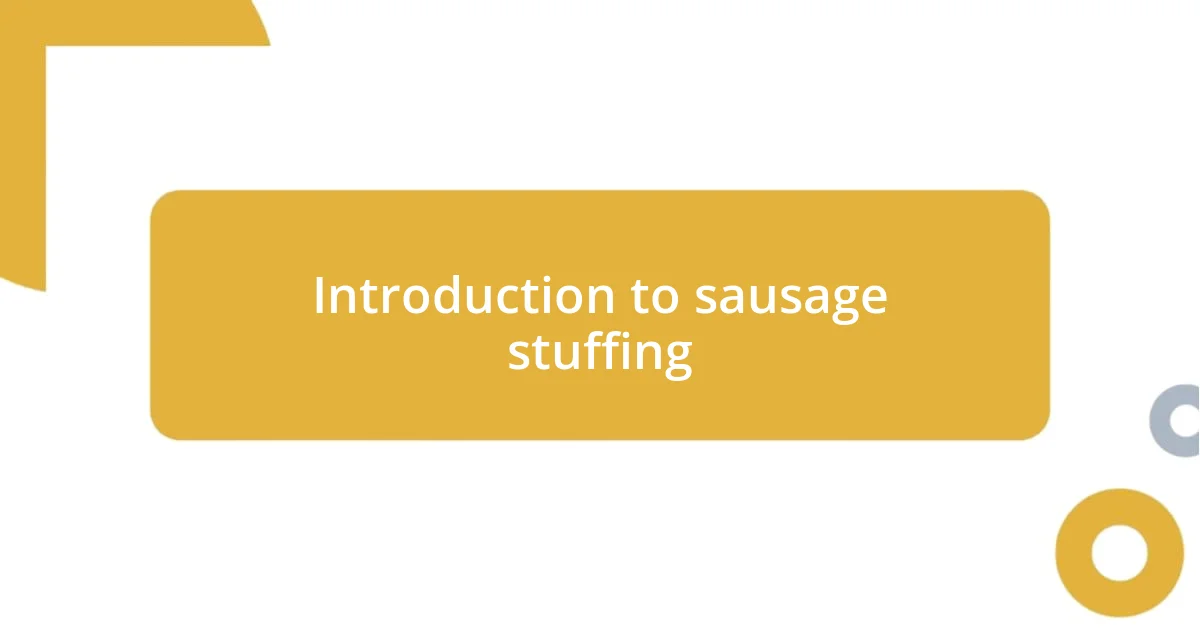
Introduction to sausage stuffing
Sausage stuffing might seem like a simple task, but it’s a craft that tells a story of tradition, flavor, and a bit of magic. The first time I stuffed sausages, I was both excited and a little nervous. Would they burst? Would they taste alright? These questions buzzed around in my mind like a swarm of bees as I gathered my ingredients.
I remember standing in my kitchen, the scent of spices wafting through the air, and feeling a rush of anticipation. Each step, from mixing the meat to filling the casings, felt like a rite of passage. It was fascinating to learn how different cultures infuse their unique twists into sausage making. Have you ever thought about how your family recipes reflect your heritage? That connection to the past made every link I crafted feel special, almost sacred.
As I gained confidence, stuffing sausages became more than just a culinary task; it transformed into an enjoyable experience filled with laughter and stories shared around the table. I often wonder how many cherished memories are wrapped up in those savory links. Sausage stuffing is not just about the end result; it’s also about the journey, the flavors, and the people we share them with.
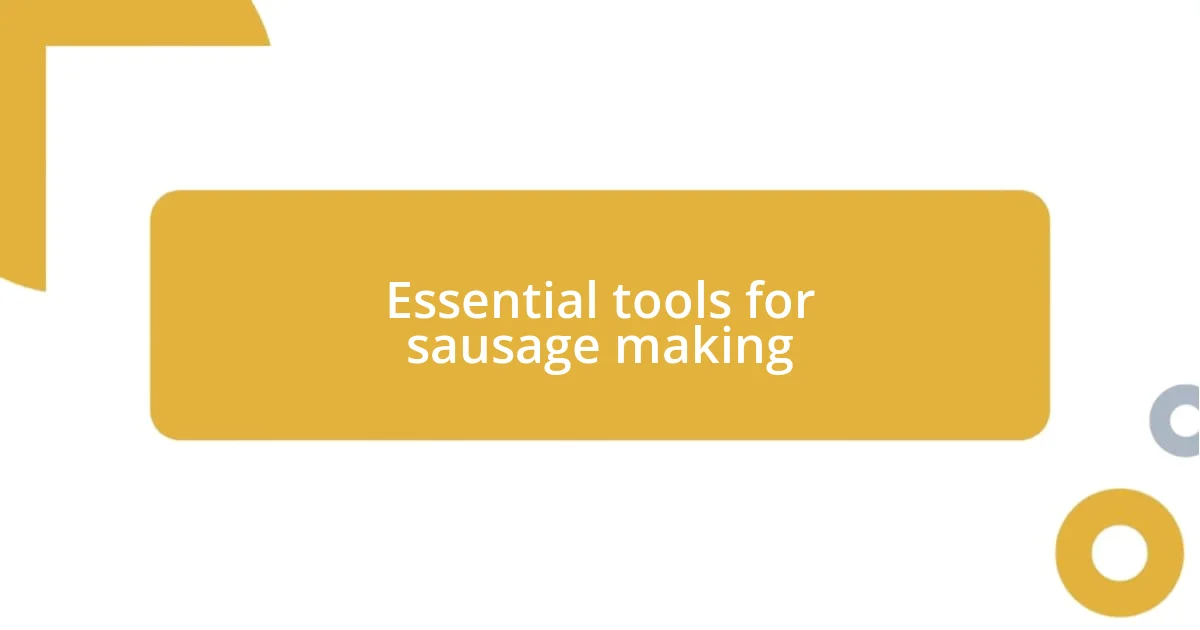
Essential tools for sausage making
When adventuring into sausage making, having the right tools is essential. I found that having a well-equipped workspace not only made the process smoother but also added to my enjoyment. For a novice or seasoned sausage maker, these tools enhance the experience and ensure tasty results.
Here are some essential tools you’ll want to have on hand:
- Sausage stuffer: A manual or electric sausage stuffer makes filling casings much easier and helps achieve consistent thickness.
- Meat grinder: Using a meat grinder allows for easy preparation of your chosen meats, yielding fresh and flavorful results.
- Casings: These can be natural or synthetic, providing the outer layer for your sausages. I recommend natural casings for authenticity.
- Temperature probe: A reliable thermometer helps monitor the cooking process, ensuring safe internal temperatures for your sausages.
- Mixing tools: A sturdy bowl and a mixing paddle are crucial for blending your meats and spices thoroughly.
- Twine: This comes in handy for tying off sausage ends or securing links, and I’ve found it beats using toothpicks!
- Cutting board: A dedicated space to chop and prep is vital for both cleanliness and efficiency.
I still remember the satisfying sound of meat being ground through my trusty grinder, and the thrilling moment when I first watched the sausage emerge from the stuffer. Each tool plays its part in making that experience enjoyable and successful. In my journey, I learned that having these essential tools not only boosts confidence but also deepens the connection to the craft itself.

Choosing the right sausage casings
Choosing the right sausage casings is a critical step in the sausage-making process. I’ve discovered there are two primary types of casings: natural and synthetic. When I first began stuffing sausages, I experimented with both, but I found natural casings added an authentic bite and a beautiful texture that synthetic options just couldn’t replicate. There’s something incredibly satisfying about using natural casings, as they feel more connected to the traditional sausage-making processes I respect.
Natural casings, typically made from the intestines of pigs, sheep, or cows, offer a wonderful flavor and crispness. I remember the first time I worked with hog casings; the slight resistance as I filled them was exhilarating. Sure, they require some extra care, as they need to be soaked and rinsed, but the end result—delicately crafted sausages bursting with flavor—was worth it. On the other hand, synthetic casings can be a convenient choice and often require less preparation, which might appeal to beginners. However, they lack the versatility and charm that natural casings bring to the table.
To help you decide on the right casing for your needs, I’ve put together a comparison table:
| Type of Casing | Advantages |
|---|---|
| Natural | Authentic taste, traditional texture, can be more forgiving when stuffing |
| Synthetic | Convenient, uniform appearance, requires less preparation |
In my experience, choosing the right casing ultimately depends on what you value more: tradition and flavor or convenience and consistency. Try a few different options and see what resonates with your personal taste and sausage-making adventure.

Preparing the sausage mixture
Preparing the sausage mixture is one of the most exciting parts of the process. After carefully choosing my meats, I remember feeling a rush of creativity as I combined different cuts to achieve the perfect balance of flavor and texture. It’s essential to ensure that your meat is well-chilled; I’ve found that chilled meat mixes more easily and prevents a mushy texture, which no one wants in their sausage.
Once I had my meat ready, the spice blends became the star of the show. Experimenting with salt, pepper, garlic, and herbs really brought out my adventurous side. I recall the first time I added crushed red pepper, and the mixture transformed into something that felt alive with flavor. Have you ever tasted something you made and immediately felt proud? That was me, knowing the spices I chose were about to become a signature part of my sausage recipe.
As I mixed everything together, I used my hands for that personal touch. It felt almost meditative, connecting me to the entire process. It’s important to mix thoroughly, so every bite of sausage bursts with consistent flavor. The sight of the mixture coming together, with every ingredient marrying perfectly, is simply satisfying. Remember, this foundation is what will ultimately define the taste of your sausages, so don’t rush it!
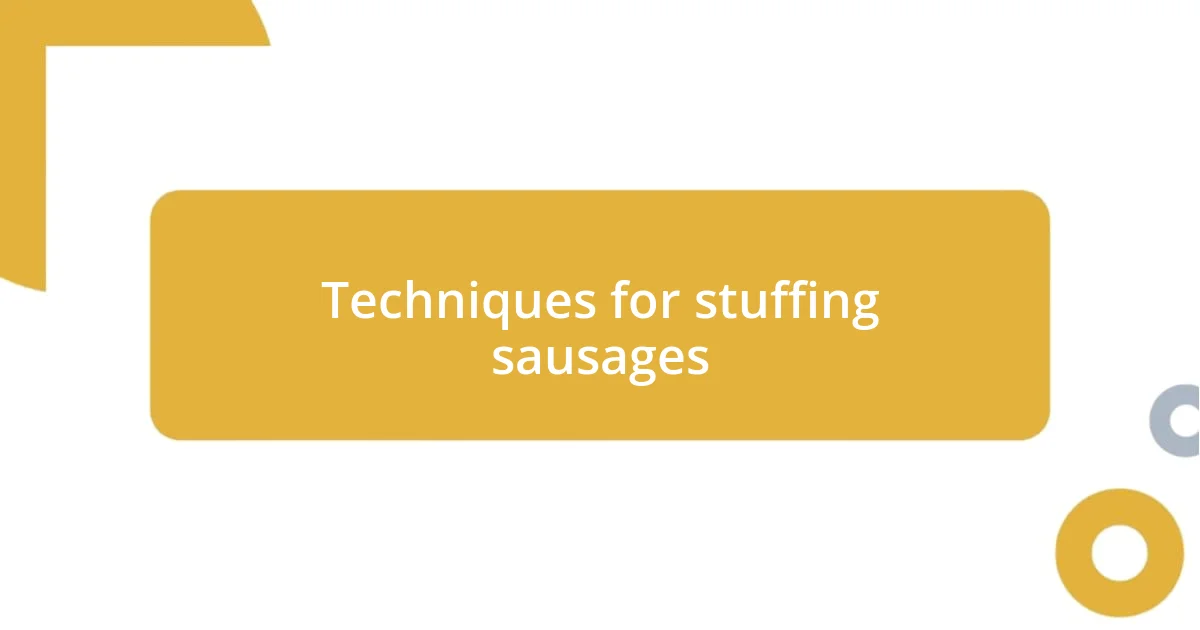
Techniques for stuffing sausages
As I dove into stuffing sausages, I quickly realized that the technique is just as crucial as choosing ingredients. One method I found particularly effective involves using a funnel or a sausage stuffer attachment on my meat grinder, which allows for consistent filling without air pockets. Can you imagine the satisfying feeling of watching the casing fill evenly, knowing that each sausage will cook up perfectly? It’s a moment of triumph that makes all the preparation worthwhile.
I distinctly recall the first time I attempted to stuff sausages on my own. I was nervous but excited, and I learned the importance of keeping my hands moist to ensure the casings slid easily over the funnel’s tip. If you’ve ever had that frustrating experience of the casing resisting because of friction, you’ll appreciate this little trick! A quick dip in water can make a world of difference, allowing the filling to flow smoothly and maintain that delicate, professional look.
Another technique that I’ve incorporated when stuffing is to take my time and not rush the process. It’s all too easy to get overly enthusiastic and end up with packed sausages that burst during cooking. I remember the disappointment of my first few attempts—let’s just say it wasn’t pretty! Now, I gently twist the sausages at intervals as I create them, which helps control the filling and gives them that classic sausage shape. Have you ever felt the satisfaction of achieving just the right twist? It’s a small moment that elevates the entire sausage-making experience.
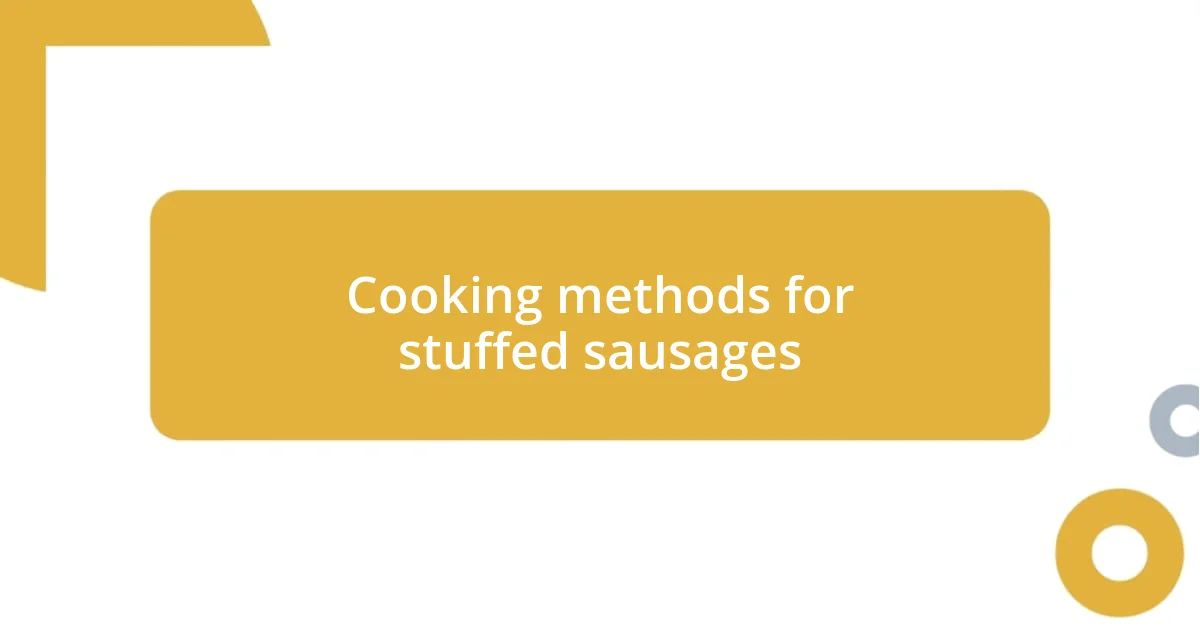
Cooking methods for stuffed sausages
Cooking stuffed sausages offers a range of delightful methods that can enhance both texture and flavor. One approach I’ve come to love is grilling. The hot flames create a beautiful char on the casings while the steam from the stuffed filling maintains moisture. Have you ever had that incredible moment when you bite into a sausage and the smoky, savory flavor bursts in your mouth? Grilling truly brings out the best in stuffed sausages, creating a symphony of smoky and juicy sensations.
Another cooking method that has become a favorite of mine is baking. I remember the first time I decided to pop my stuffed sausages in the oven—it felt like an experiment. As they bathed in the warmth, a wonderful aroma wafted through my kitchen, tempting me to sneak a taste before they were ready. The even heat allows the flavors to mingle while keeping the casings crispy, creating the perfect bite. Plus, it leaves me free to prepare side dishes while they work their magic; it’s a win-win situation.
For a heartier experience, I also enjoy simmering my stuffed sausages in a flavorful broth or sauce. I vividly recall a rainy Sunday afternoon when I tossed my sausages into a pot with tomatoes, herbs, and wine. It became a labor of love, and as they cooked, the scent enveloped my home, making everything feel cozy and warm. This method infuses the sausages with extra flavor and results in a dish filled with rich, comforting essence. Have you ever watched something you created transform in front of you? It’s a feeling that reminds me why I love cooking.
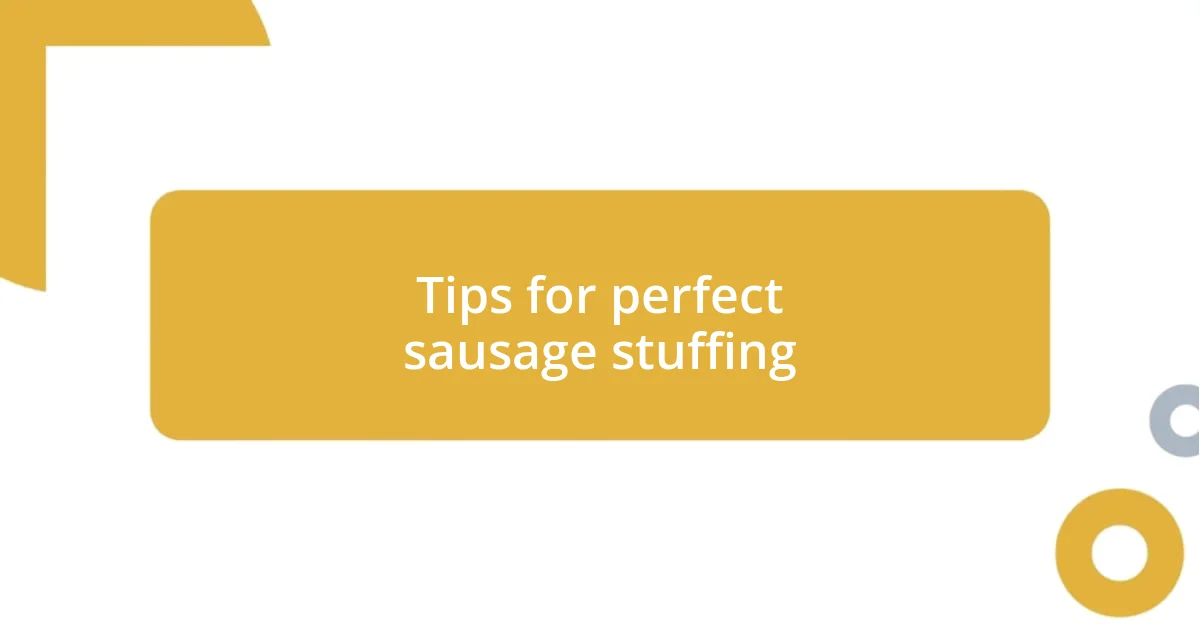
Tips for perfect sausage stuffing
When it comes to perfecting your sausage stuffing, one of the best tips I can offer is to chill your filling before stuffing. I remember the first time I stuffed sausages and my mixture was a bit warm; the casings became slippery and hard to manage. Once I tried chilling the meat for about 30 minutes, the texture improved dramatically—it was easier to handle, and my sausages turned out so much more consistently. Do you know how crucial it is to have a firm filling that holds its shape? It’s a game changer!
Another aspect that deserves attention is the seasoning. I’ve learned that tasting your filling before stuffing is essential—don’t shy away from experimenting a bit. A few drops of wine or a sprinkle of herbs can elevate the flavors to new heights. I still vividly recall the time I added garlic and rosemary to my sausages, and the entire batch felt like a celebration of taste. Have you ever tasted something and thought, “Wow, I created this!”? It can be so fulfilling to know that little tweaks can lead to remarkable results.
Finally, don’t forget to let your stuffed sausages rest for a bit after sealing them. This might seem unnecessary, but I’ve found that the flavors meld together beautifully during this time. After my initial attempts, where I immediately cooked them, I decided to cover them and let them rest for about 30 minutes. The difference was profound; the sausages had a deeper flavor and a more satisfying bite. How often do we overlook this simple step? Trust me, giving them time to rest will reward you in delicious ways!















